Meshyrich (Kaniv)
| Meshyrich | ||
| Межиріч | ||

|
|
|
| Basic data | ||
|---|---|---|
| Oblast : | Cherkasy Oblast | |
| Rajon : | Kaniv Raion | |
| Height : | 83 m | |
| Area : | Information is missing | |
| Residents : | 904 (2006) | |
| Postcodes : | 19035 | |
| Area code : | +380 4736 | |
| Geographic location : | 49 ° 38 ' N , 31 ° 26' E | |
| KOATUU : | 7122085101 | |
| Administrative structure : | 3 villages | |
| Address: | 19035 c. Межиріч | |
| Statistical information | ||
|
|
||
Meschyritsch ( Ukrainian Межиріч ; Russian Межирич Meschiritsch ) is a village in Kaniw Raion in the Ukrainian Cherkassy Oblast with about 900 inhabitants. There is a Paleolithic site in the village .
geography
Meschyritsch is on the regional road P – 10 22 km south of the district center Kaniw at the confluence of the Rossava (Ukrainian Росава ) in the Ros . The district council Meschyritsch, whose center is the village, also includes the villages Babychi ( Бабичі ) with about 160 inhabitants and Luka ( Лука ) with 410 inhabitants.
Paleolithic site
The Paleolithic site is estimated to be around 13,000 BC. Dated. Five round huts with a diameter of 4 to 7 meters were built from mammoth bones on the hunter-gatherer camp site. The cabins covered areas from 8 to 24 m². The base of one hut consisted of lower jaws, that of the other mostly of long tubular bones. The superstructure was made up of carefully nested bones and the top end of tusks joined together. The rotunda was probably covered with furs and sods.
Between 150 and 650 bones were built into each hut; a total of 109 lower jaws, 97 skulls, 92 tusks and several hundred large bones. The largest hut consisted of 20 tons of bones, including 95 lower jaws, 46 skulls and 40 tusks. A skull weighs around 100 kg and a tusk can weigh 200 kg. The bones of the same individual were found in different huts. Presumably they came from a natural mammoth cemetery in the area.
It is believed that on the residential space were staying at the same 30-60 people. Each hut had a stove . Outside the dwellings there were also fire places and workplaces for the production of flint and bone tools as well as storage pits.
A mammoth skull painted with red ocher was discovered in a hut . Perhaps, as finds from Mesyn show, it served as a drum (musical instrument). An engraving on a piece of mammoth ivory could represent the huts of the living space and then be the oldest known map. More recent representations, interpreted as maps, are in the Val Camonica .
literature
- Sergei Nikolajewitsch Bibikow: Drevneishii Muzykalnyi Kompleks iz Kostei Mamonta: Ocherk Materialnoi i Dukhovnoi Kultury Paleoliticheskogo Cheloveka (The Oldest Musical Complex Made of Mammoth Bones). Akademiia Nauk Ukrainskoi SSR, Institut Arkheologii. Kiev, Ukraine 1981.
- IH Pidoplitschko: Upper Palaeolithic dwellings of mammoth bones in the Ukraine: Kiev-Kirillovskii, Gontsy, Dobranichevka, Mezin and Mezhirich, Oxford: J. and E. Hedges 1998. ISBN 0-86054-949-6 .
Web links
- Description of the Paleolithic site
- Ancient inventions of Ukraine - The oldest house in the world in Meschyritsch (English)
Individual evidence
- ↑ Location on the official website of the Verkhovna Rada , accessed on December 13, 2014


